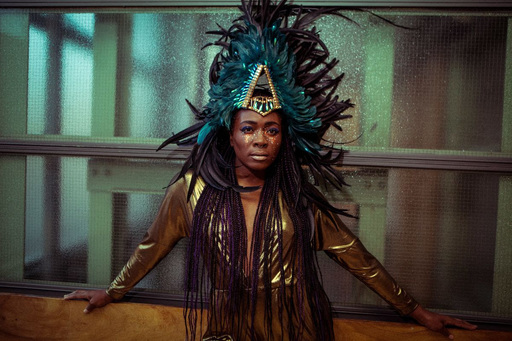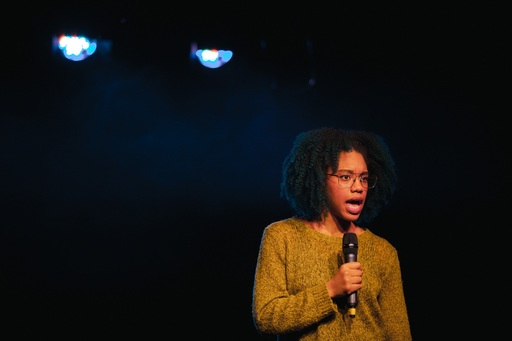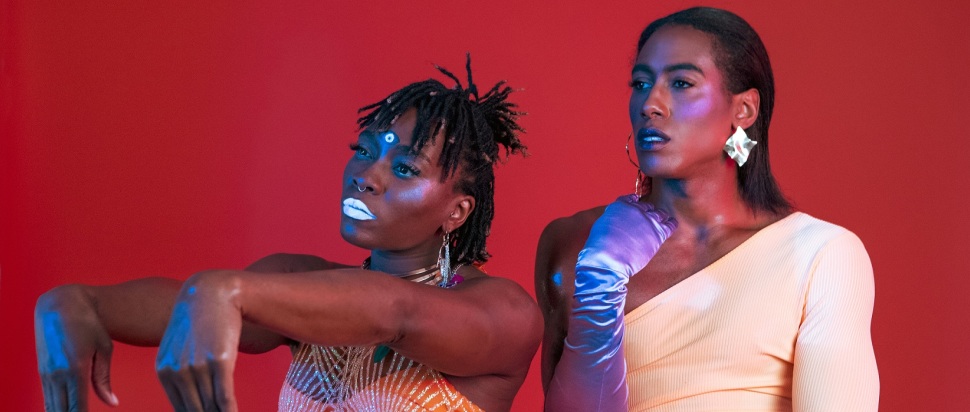Creating Space: Fringe of Colour
Fringe of Colour is working to make the Fringe as accessible as possible for young people of colour. The scheme’s pioneer, Jessica Brough, speaks to performers Rachael Young and Kemah Bob about how the scheme impacts artists of colour as well as audiences
Fringe of Colour (FoC) is back for its second year and it has evolved since beginning in 2018 as a public database of shows by performers of colour. Now, it exists as a database, a social media platform, a free ticket scheme, and a means to connect people of colour in Edinburgh during the festival who are here to work, perform, watch shows or just continue living their lives. Because at the heart of FoC is the need to connect with and find one another.
I spoke to a couple of performers coming to the Fringe this year about creating and taking up spaces and tackling isolation in a majority-white environment. Their shows are three out of the 19 taking part in FoC’s ticket scheme, an initiative that allows young people of colour to access shows by artists of colour for free.
Rachael Young on Nightclubbing and OUT

Jessica Brough: Tell me about your show Nightclubbing, Rachael.
Rachael Young: Nightclubbing was made about DSTRKT – you know about that, right?
JB: Yeah, a few Black women went on a night out to the London nightclub, DSTRKT, and were refused entry by the bouncers.
RY: It’s not like these things don’t happen all the time, but the media interest around DSTRKT stayed with me. I remember, not long after it, doing something for Black history season. We were performing for mostly-white audiences and it was like we could only celebrate ourselves one point in the year, or are only given spaces for one month. Even in those times of the year people are still policing our bodies and policing where we can go.
JB: Totally, even when you just want to dance somewhere.
RY: You just want to let loose and you can’t even do that. Also, as a dark-skinned Black woman I had to ask: what the hell do you have to do? How the hell can you be? When is it that you start to be seen as desirable? When do people decide that? It made me start thinking about who is there in the public eye who’s a dark-skinned Black woman that has managed to make her life transcend all of that? And that made me think of Grace Jones, who is so interesting to me because she has a dark-skinned complexity and she’s a bit androgynous, she performs masculinity and femininity in her work. She is unapologetic. She hasn’t bleached or lightened her skin. As someone who is queer, I felt a connection to her.
The whole thing about Nightclubbing is about taking up as much space as possible, which is a very different experience to how I live my life in the world.
JB: For those women who were refused entry to the nightclub, is the solution that they should try to find a way to take up space in these nightclubs or should we be creating our own spaces where we don’t even have to think about actively doing that work?
RY: I would say define your own spaces because, in Nightclubbing, I’ve created my own space, and everyone gets let into my space. No one wants to be constantly knocking on a door saying ‘let me in, let me in.’
JB: Creating space for young people of colour to go to shows like yours is something I’ve definitely found challenging with the FoC work, specifically with the ticket scheme. I’ve had to constantly explain why it’s young people of colour and shows by people of colour that we’re focusing on, because obviously getting any young people into the theatre is great, but it’s not a given that certain people will feel like they are invited. The thing we want to do is say that this is here for you and you are allowed and this is an actual, explicit invitation for you to join.
RY: So many things are exclusive. It’s so expensive that the people who need to see that show won’t be able to see it, or there’s that idea of how you have to be in those spaces. When I made OUT, the last show we made before we started touring, it was the best show because the audience were predominately Black and queer and they were so vocal. It really changes the show.
JB: I’ve felt that at the Fringe, when I’ve gone to see shows with Black friends. I was sitting near the back with five other Black friends last year in a show about American slavery, mental health and trauma. There were moments of comic relief where they were telling jokes and it was so funny, but the white audience just didn’t respond to that, while we were at the back whooping and cheering. That experience might not have been the same if I’d gone with white friends who might not have got the jokes, or if I’d gone by myself, or if I had been one of those white audience members. That’s why the ticket scheme is centred around groups going to shows. I’m trying to create an online group where people can see shows together. There is a great joy in seeing something that celebrates an aspect of you with people who get it. Hopefully it’ll help people process the experiences as well. With someone to talk about it after, or poke in the side and give that knowing look to during the show.
Nightclubbing (31 Jul-11 Aug) & OUT (13-25 Aug, not 19), Summerhall (Old Lab), 3.45pm, £8-12
Nightclubbing photo by Marcus Hessenberg
Kemah Bob on Femmes of Colour Comedy Club

JB: Kemah, what was your inspiration for FOC It Up: The Femmes of Colour Comedy Club?
Kemah Bob: The Cocoa Butter Club! It’s a cabaret that centres performers of colour. To see the host, Sadie Sinner, speak her truth up there and say to the audience: ‘This is a space that centres Black bodies and I created it because, when I was growing up, I didn’t see bodies like ours doing what we do.’ It was that simplicity of creating a space that centres us. We’re tired of being the only Brown or Black person on the line-up, we’re tired of being tokenised, we’re tired of the racism within our industry. Cocoa Butter Club’s host called it a creative clapback and I loved that.
JB: Does it make a difference knowing that there are going to be people of colour in the audience?
KB: I see FOC It Up as a place where people of colour get to see themselves reflected, whether it be on stage and you get to see yourself reflected in the audience, or in the audience and you get to see yourself reflected on stage. I really like the idea of providing a different experience for comedians in that room, and for audience members who aren’t people of colour to hear something that they may not normally and that may challenge them. I know for myself I deliver things differently – all comics do – depending on what room you’re in.
JB: I saw Hot Brown Honey the second year I came and that just lit me up, I hadn’t seen anything like that before. It made me want to be involved in something that is so temporary in Edinburgh but can have such an impact for the rest of the year.
KB: Them and Cocoa Butter Club have shaped my understanding of what’s possible and what you can say and how you get to decide that – and that you can have an audience. You don’t have to be afraid that you’ll scare off your income.
JB: That part of being afraid of not having an audience is what I’m trying to achieve with the ticketing scheme and the spreadsheet – to take some burden off performers. We’re going to find you at least six people to come to the show!
KB: So, FoC started as a spreadsheet and then shifted into a ticket scheme?
JB: Yes, it’s very much inspired by the Black Ticket Project, which was set up in London and worked with local youth groups to make it easier for young Black kids to go theatre productions. The community aspect really interested me, and it being about going and experiencing a show with other people and whooping, laughing and crying together – it really changes your experience of a performance. I knew so many people who live in Edinburgh and have never been to the Fringe because it has this reputation of whiteness...
KB: ‘What would I see? Who would I go with?’
JB: Exactly. ‘Will I feel comfortable? Who will I go with? Can I afford it?’ Equally, you’ve got performers who are bringing shows up and the people they want to see their shows can’t see their shows. Those are two problems that are interconnected and ones I thought could be partially solved with a ticketing scheme and promotion.
KB: I think it’s so brilliant and so necessary. I was fortunate that in my first year at the Fringe I was able to use the FoC spreadsheet and cut through the noise.
There’s also that thing of when you do something for communities of colour and when you create something that serves them, it is appreciated. Even things that wouldn’t have occurred to us that we needed, it is appreciated it. It shifts how we’re able to approach the Fringe and understand it.
JB: That’s the thing – I’ve had conversations with performers considering not coming to the Fringe because of the bullshit that comes with being here as a person of colour. It really angers me when I see people who don’t experience the barriers just glide through these spaces. It’s unfair and unequal. If I can do anything to level that playing field and take off some of that burden, if someone was considering not coming because of the whiteness of Edinburgh, I’ll feel good.
KB: At the end of all this it’s about support, and that’s what your scheme is about.
JB: When we talk about activism, I don’t think we talk enough about how loneliness plays a part in it. If I didn’t do things like FoC or get involved in the schemes other people are doing and find the other queer people of colour around, I’d be so lonely and my experience of just living would be very different. I think loneliness drives a lot of the work that is done in these spaces.
KB: It’s wanting people to feel seen and understood. It’s getting people in a room where someone on stage says that they were the only Asian girl in their town and someone in the audience recognises that and says ‘Yeah, I know that feeling.’ It’s being able to have those moments where we’re together – knowing someone has felt what you’ve felt is so powerful.
JB: Where do you see FOC It Up going?
KB: I see FOC It Up being a global network of comedy clubs in different cities. The next thing I’d like to see is FOC It Up on TV, producing our own content and sharing it on our platforms. We want to empower people to ask for more and to expect more and be supportive. Comedy is one of those things where you have to have the confidence to do it.
This was something I was thinking about when I was getting into it, like why am I entitled to work like this and speak my mind and voice my opinions? Well if there’s anyone who should be getting paid to voice their opinions it’s fucking me! That’s what FOC It Up is all about and getting people involved. We should be out there speaking our minds and getting paid. You need confidence and a story to tell to do comedy, and there are so many people of colour who have stories to tell.
FOC It Up: The Femmes of Colour Comedy Club, Gilded Balloon Patter Hoose (Doonstairs), Fridays & Sundays, 11.15pm, £8-10
Kemah Bob photo by Method Video
Inspired by The Black Ticket Project founded by Tobi Kyeremateng, this scheme has been set up in collaboration with the Fringe Society, who handle our bookings, and seven Fringe venues (Assembly, Gilded Balloon, Pleasance, Scottish Storytelling Centre, Summerhall, Traverse and Underbelly), who have funded these tickets. If you are a young person of colour, you can get access to over 500 tickets through our website on the ‘How to book’ page. You can also stay connected via Twitter at @FringeofColour and using the #FringeofColour hashtag.
